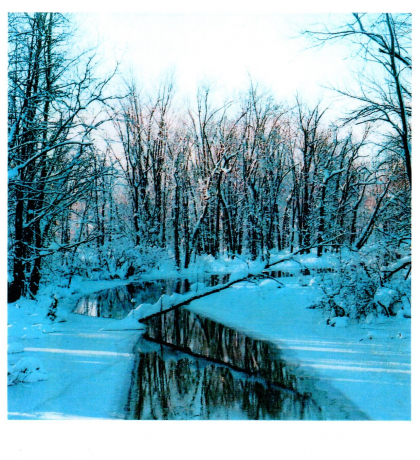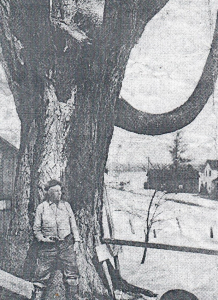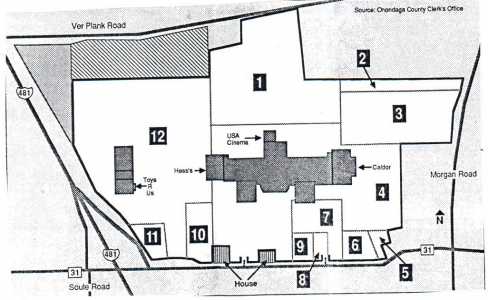Clay WintersPosted on December 2, 2020 |
Image

|
HISTORY MYSTERY: Clay Winters
This photo is a winter shot of Mud Creek, a very long waterway. Also nearby is Mud Mill Road in the Caughenoy area. They were named by the early Young family who settled Clay around 1812 when one of them built a Mill on the creek but found that it only was functional in early spring and was very muddy the rest of the year. Carl Sotherden lived on a farm on Caughdenoy Road with his wife Martha and their children. She was his partner on the farm and was very active in the town and in the choir from childhood until a few years before she passed away at 98. Martha and I became close because we sat next to each other in the alto section of the church choir. She gave me Carl’s original manuscript* on living in Clay and following are some memories of Clay winters in his own words.
“There were a few ice houses for storing ice out here in the country. The Thrifty hotels were the leaders in this practice and in an emergency, one might buy a chunk of ice from them. These ice houses had to depend on local farmers to draw the ice from either the Oneida River or Lake, whichever had the better quality ice. The ice was mostly drawn on bob sleighs pulled by a well-shod team of horses. A small gas engine was used to elevate the blocks of ice up a chute to load and a smaller device to run it up into the ice house where it was securely packed in sawdust secured from the local saw mills. The ideal ice was made of frozen water free from snow layers if possible. So, there was a right time and place for cutting and storing. When I first remember, a single horse was used to draw a chisel plow to score the ice. Then men with ice spuds could generally break off the blocks and float to the chute with the aid of a pike pole. The ideal cake size was about two by three feet and about 20 to 24 inches thick.
“Home made ice cream socials were very popular in those days during the summer months at the local churches – Immanuel was well known for them. My mother served on the committee many times and I got to go down to the church as a crank turner. I kept the can turning in the brine as well as the ladle on the inside. The turner got to lick the ladle when his can was frozen and boy was it ever good! A two-scoop dish of ice cream sold for ten cents and a one scoop for five cents. One regular customer used to eat ten or twelve dishes at one sitting.
“There were three mail routes delivering mail from the Clay Post Office when I was old enough to remember. All were delivered by horse and buggy; the mailmen were: Route One’s George Moore; Route Two’s Frank Sotherden (my uncle); and Route Three’s William Hughson. Sometimes it was tough to make all the deliveries because of bad road conditions in the winter.
They were unable to get through until some of the farmers finished their chores and took their team to front a bob to break open the roads so they might be traveled by a cutter. A good team of horses that knew how to wallow the deep snow was a real asset in those times.
“One blustery morning there was an urgent request for snow shovelers that came over the party telephone line. It seems that late in the afternoon or early evening the day before, a passenger train heading north on the Watertown N.Y.C. Railroad had become bogged down in the deep snow that completely filled the cut at the back of our farm. I remember hearing he screeching of the spinning steam engine wheels on the steel rails as they tried to force their way through the deep drift. One of the engine wheels got off the track and in the blowing snow it was impossible to get back without moving the snow packed around the engine. In those days, there was a station agent at most of the train stations and they maintained a telegraph service to control the train traffic. The local agent was contacted to have food, etc. sent from the local stores by snowshoers for the train passengers. The next morning, a group of able-bodied farmers and laborers was organized to go to the stranded train and shovel the snow up the bank from one to another until the dislodged wheel was uncovered and the train workers could get the wheel back on track. The local grocery stores were pretty well cleaned out of their ready-to-eat items as they supplied the train passengers with eats on their unexpected delay.”
Of course, in 2020 winter will be handled much differently. Very soon, we will be experiencing another Clay winter.
*Original manuscript by Carl Sotherden was called simply “Reminiscing.”
Dorothy Heller, Historian
10-14-20
Other
History Mysteries

Surviving on a Farm 100 Years Ago
History Mystery | Dec 2, 2020
HISTORY MYSTERY: Surviving on a Farm 100 Years Ago


